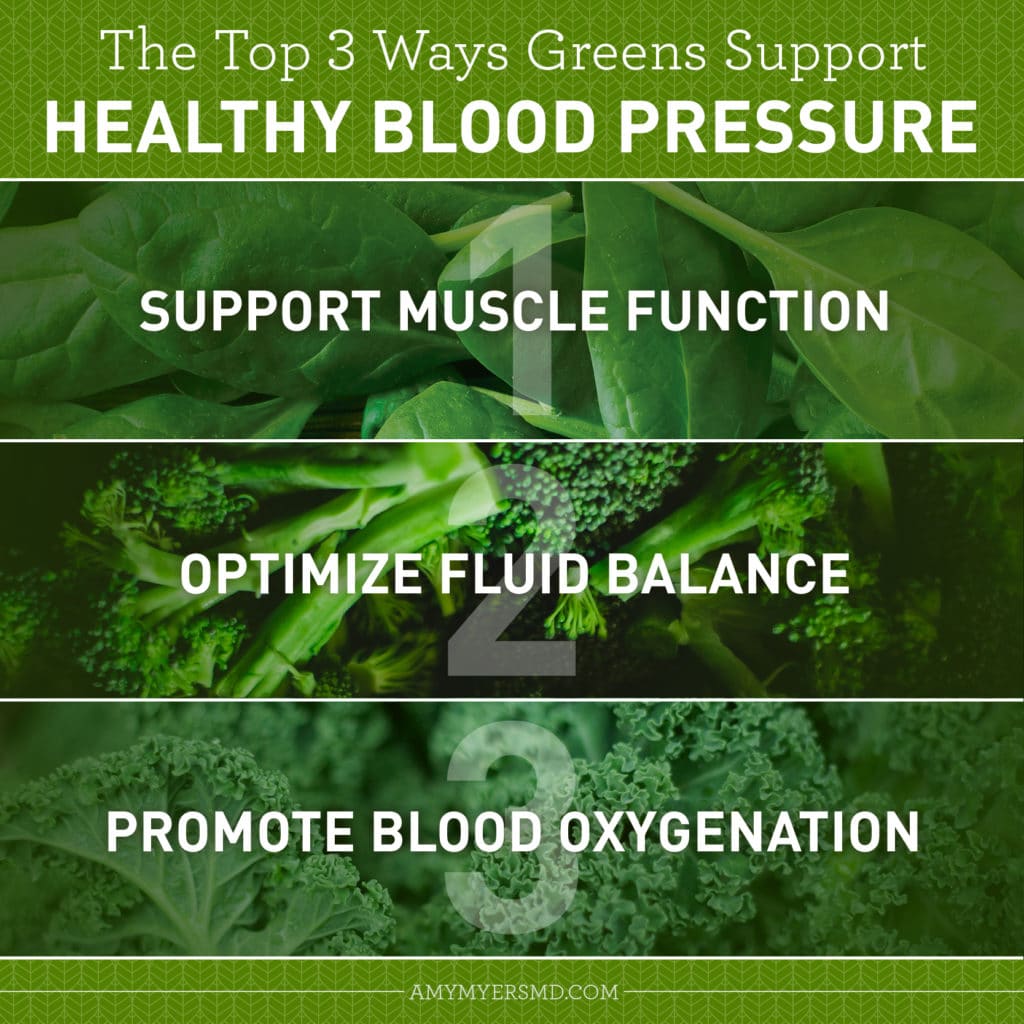Whether we like them or not, greens including kale, spinach, and broccoli are the undeniable superstars of the food world. Low in calories, yet high in fiber, vitamins, minerals, and phytonutrients, greens are incredible for your health — including your cardiovascular system. Fortunately, especially for those who don’t love the taste of those all-important organic green veggies (I’m looking at you, Xavier!) my Organic Greens powder is a great way to get your daily dose.
Before I get into the ways greens can support a healthy blood pressure I’ll recap why having high blood pressure can be detrimental to your health. Then I’ll talk about how organic greens can benefit you and how they do it. When you understand how truly amazing organic greens are, you’ll be a lifelong green juice fan, even if you can’t bring yourself to belly up to a bowl of kale.
[lwptoc]
What is High Blood Pressure?
High blood pressure, also called HBP or hypertension, occurs when the force of your blood pushing against the walls of your blood vessels is too high, like a hose that can’t handle the force of the water running through it.
When your heart beats, it creates pressure — just like a pump — that carries blood through a network of arteries, veins, and capillaries. Blood pressure consists of two measures. The first is the systolic blood pressure, which occurs as blood is pushed out of your heart and into the arteries that are part of the circulatory system. The second is the diastolic blood pressure which is created as the heart rests between heartbeats.
These two forces are represented by the numbers in a blood pressure reading. The top number is the systolic pressure and the bottom is the diastolic pressure. New guidelines have recently been developed that measure high blood pressure as anything over 130/90.1 The only way to know for sure where you stand is to have your blood pressure checked.
How Common is High Blood Pressure?
According to the Centers for Disease Control, about 75 million Amerian adults have high blood pressure. That’s about one-third of the population.2 Before age 55, men have a greater chance of having high blood pressure while women are more likely to have high blood pressure after menopause. There’s also a good chance you don’t even know you have it. And that’s an issue because even a small increase in blood pressure can have serious consequences: every 20/10 increment over 115/75 increases your risk of coronary heart disease and stroke.3
What to Do About Hypertension?
If you are seeing a conventional physician for HBP, he or she has likely advised you to lose weight, cut your salt intake, and avoid fatty and fried foods. What your doctor probably didn’t tell you — and may not even know — is that while hypertension and heart disease tend to rise with age in the US, it is not an inherent part of the aging process. In fact, the relationship between diet, lifestyle, and heart health in other cultures offers solid evidence that high blood pressure can often be controlled without medication.
Even better, through a healthy lifestyle such as The Myers Way® which of course includes the avoidance of risk factors such as smoking and being overweight, it’s possible to stave it off. So now we know what high blood pressure is and who it affects, let’s turn to how greens can help.
 Dr. Amy Myers
August 19th, 2019
https://content.amymyersmd.com/article/greens-support-blood-pressure/The Top 3 Ways Greens Support – Infographic – Amy Myers MD®
Dr. Amy Myers
August 19th, 2019
https://content.amymyersmd.com/article/greens-support-blood-pressure/The Top 3 Ways Greens Support – Infographic – Amy Myers MD®
1. Support Muscle Function
Magnesium is a crucial element for your body and plays an important role in bone health, protein manufacture, and muscle function, including that all-important muscle — your heart. In addition to magnesium’s capacity to help manage heart rhythm disorders, magnesium has been shown to support a healthy blood pressure.4 High levels of magnesium in the blood have been linked to improvements in blood flow, another factor associated with lowered blood pressure.5
Spinach, Popeye’s trusty standby and one of the foods we often associate with good health and vitality, is rich in magnesium. Just a half-cup serving has 78 mg of this nutrient. That’s about ¼ of a woman’s recommended daily allowance.
2. Optimize Fluid Balance
Potassium, a mineral and electrolyte found in abundance in greens, is essential to keeping an optimal fluid balance in your body. A diet high in sodium (often due to eating highly processed foods) must be kept in check by adequate potassium intake. Potassium lessens the effects of sodium because the greater the amount of potassium you eat, the more sodium you pass in your urine. An adequate potassium level also helps to ease tension in your blood vessel walls, which helps further lower blood pressure.
Once again, spinach can be an important source. However, another great option is broccoli, which has almost 500 mg of potassium per cooked cup,6or about 20% of your daily value. It’s an extremely versatile vegetable that can be boiled, steamed or sautéed with garlic and olive oil. It can also be easily incorporated into soups and casseroles.
3. Promote Blood Oxygenation
The mineral iron is critical for your blood health. Having enough iron means your blood cells can carry oxygen throughout your body, one of your circulatory system’s most important functions. A recent study has shown that a lack of iron, also called anemia, is a factor in 30% to 50% of patients with heart failure. Iron is also critical in muscle function, so a lack of iron can directly affect the heart, which in turn can impact blood pressure, Furthermore, anemia can actually result in smaller blood cells which impact blood volume and pressure.
Spinach comes to mind for iron as well (no wonder Popeye loves it!) however, kale is a great choice for your blood on at least two counts. First, a single serving contains at least a gram of iron per serving. That may not seem like a lot but iron can only be absorbed if there is an adequate supply of vitamin C. Fortunately, that same serving of kale has 134% of the typical daily value of vitamin C — much more than spinach has — so the iron in kale is readily available for your blood.
The Best Way to Add Greens to Your Diet
While it’s ideal to get these incredible benefits from real, whole foods, I completely understand that not everyone is a fan of how greens taste, has time to shop for and prepare them or even knows the best cooking method to get the optimal flavor from them. Add to that the fact the greens may not be grown in optimal soil, that organic varieties can be difficult to come by, especially at certain times of the year and that it can be difficult to get enough of these nutrients from diet alone in even the best of circumstances, and it can be downright discouraging!
That’s why an Organic Greens powder is a great option to have on hand for when you’re just too busy to prep a big salad or cook a tasty meal. With a powder, you know exactly which nutrients you’re getting and how much of it. It’s also a great way to maintain healthy habits while on-the-go or traveling.
One scoop of my Organic Greens powder is a nutritional powerhouse, containing 14 USDA certified organic plant foods, including the green superstars spinach, broccoli, and kale that support healthy blood pressure, as well as alfalfa, moringa, broccoli sprouts, spirulina and chlorella for additional nutrients that benefit your whole body. My Organic Greens powder is an easy and convenient way to ensure you’re getting your daily greens along with all the heart-healthy, blood-pressure support they provide.
Article Sources
- https://www.heart.org/en/news/2018/05/01/more-than-100-million-americans-have-high-blood-pressure-aha-says.
- https://www.cdc.gov/bloodpressure/facts.htm#:~:text=Nearly%20half%20of%20adults%20in,are%20taking%20medication%20for%20hypertension.&text=Only%20about%201%20in%204,have%20their%20condition%20under%20control..
- https://www.ncbi.nlm.nih.gov/pubmed/12748199.
- https://www.ncbi.nlm.nih.gov/pubmed/9719052.
- https://newsroom.heart.org/news/magnesium-may-modestly-lower-blood-pressure.
- https://ndb.nal.usda.gov/ndb/foods/show/301765?man=&lfacet=&count=&max=&qlookup=&offset=&sort=&format=Abridged&reportfmt=other&rptfrm=&ndbno=&nutrient1=&nutrient2=&nutrient3=&subset=&totCount=&measureby=&Qv=1&Q337114=1&Q327383=1&Q327384=1&Q327385=1&Q327386=1&Qv=1&Q337114=0.5&Q327383=1&Q327384=1&Q327385=1&Q327386=1.

